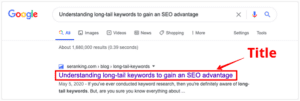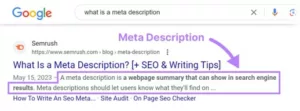Optimising Title Tags & Meta Descriptions For Maximum Impact
In the ever-evolving world of search engine optimisation (SEO), content is king. But let’s face it, even the most captivating content can get lost in the crowded digital wilderness if nobody sees it. That’s where the unsung heroes of SEO come in: title tags and meta descriptions. These concise snippets are the first impressions your website makes on search engines and potential visitors, and optimising them is crucial for attracting clicks and boosting your ranking.
The Title Tag – Your Captivating Headline
Think of your title tag as your website’s headline – it’s the first thing users see and the key to grabbing their interest. Here’s how to craft a title tag worthy of a standing ovation:
Keywords are Key: Include relevant keywords naturally, targeting both high-volume and long-tail variations. Remember, relevance trumps keyword stuffing!
Clarity is King: Keep it concise (ideally under 60 characters) and clear, accurately reflecting the page’s content. Think informative, not cryptic.
Uniqueness is the Spice of Life: Avoid duplicate titles – each page deserves a unique identity.

The Meta Description: Your Compelling Sales Pitch
The meta description acts as your elevator pitch, enticing users to click through. Here’s how to craft a meta description that seals the deal:
Keywords Weave Their Magic: Again, relevant keywords are crucial, but ensure they flow naturally within the text.
Benefits Take Centre Stage: Highlight the value proposition, showcasing what users gain by clicking.
Emotional Appeal: Infuse your description with a touch of intrigue or excitement to pique curiosity.
Call to Action: Don’t leave them hanging! End with a clear call to action, prompting users to click.
Character Count Matters: Aim for between 155-160 characters, ensuring the full description appears in SERPs.

The Benefits of Optimised Titles and Descriptions:
Think of your title tag and meta description as your digital storefront window. A well-crafted window enticingly displays your products, drawing customers in. Likewise, optimised titles and descriptions:
Increase Click-Through Rates (CTR): Compelling headlines and informative descriptions pique user interest, making them more likely to click through to your website. Studies show that optimising titles can increase CTR by up to 30%, and including strong verbs in meta descriptions can boost it by 9.6%.
Enhance Brand Awareness: By incorporating your brand name and messaging into your titles and descriptions, you reinforce brand recognition and build trust with potential customers.
Drive Targeted Traffic: Optimising for specific keywords attracts users actively searching for those terms, ensuring your website reaches the right audience.
Boost Conversions: Clearly communicating the value proposition in your meta description entices users to not only click through but also take the desired action, whether it’s making a purchase, subscribing to a newsletter, or downloading content.
The Perils of Neglecting Optimisation:
Just as a cluttered, uninviting storefront window can deter customers, neglecting title and description optimisation can have negative consequences:
Low CTR: Unclear or irrelevant titles and descriptions fail to grab user attention, leading to missed opportunities and wasted content.
Poor Search Engine Ranking: Search engines might struggle to understand your content’s relevance, resulting in lower rankings and decreased visibility.
Missed Brand Building: Without incorporating your brand message, you miss out on valuable opportunities to build brand awareness and recognition.
Lost Conversions: Unclear or uninteresting descriptions fail to entice users to take the desired action, hindering your conversion goals.
Beyond the Basics: Mastering the Art of Optimisation
Remember, simply including keywords isn’t enough. Here are some advanced tips to truly master the art of title and description optimisation:
Embrace Long-Tail Keywords: Target specific, longer phrases (4-5 words) that users search for, rather than generic keywords with high competition. For example, instead of “fitness,” consider “best home workout routines for beginners.”
Localise Your Efforts: If your business serves specific locations, include relevant city or region names in your titles and descriptions. For example, “yoga classes in London” or “plumbing services near Battersea.”
Craft Compelling Calls to Action: Encourage users to click through with action verbs like “Learn More,” “Discover Now,” or “Shop Today.” Example: “Download our free eBook: 10 SEO Hacks for Higher Rankings” instead of just “SEO eBook.”
Test, Refine, Repeat: Don’t be afraid to experiment with different variations of titles and descriptions. Use A/B testing tools to see what resonates best with your audience and continuously refine your approach.
Remember, title tags and meta descriptions are not static entities. They require ongoing analysis, refinement, and testing to consistently deliver maximum impact. By following these tips and embracing a data-driven approach, you can transform your humble snippets into SEO powerhouses, attracting traffic, boosting rankings, and achieving your content marketing goals. So, unleash your inner wordsmith, optimise those tags and descriptions, and watch your website shine even brighter on the SERP stage!

